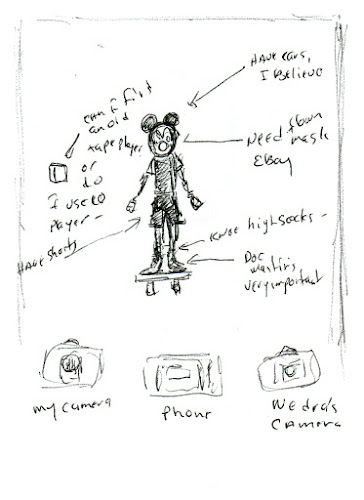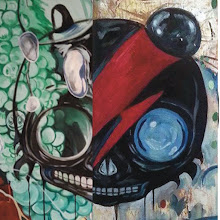Performance at King Street Station:
Oracion al Borde del Apocalipsis
Gus was a Mexican Ghost/Ghost Walk/Prayer at the Edge of the Apocvalypse
December 5th, 2019
The performance “Oracion al Borde del Apocalipsis” ( Prayer at the Edge of the Apocalypse) begins with a pre-performance piece entitled “Gus Was a Mexican Ghost,” which is a children’s book from the 1970’s about a ghost, who goes to Mexico. The book was one of my favorites as a child. This performance is an extended prayer for all of those that have migrated to this country or whose descendants travelled to these lands from somewhere else, which is to say everyone but this land’s indigenous peoples—everyone else is a guest here. This is a performance that deals directly with the looming threat that many immigrants to our country and perhaps all “people of colors” (my term, chosen because it speaks to all the different colors that we are,) feel acutely, today, in the “land of the free.”

Xavier Lopez is a contemporary, Latino/x, conceptual, mixed media artist. Lopez received his MFA from the University of California, Davis, where he created the theoretical/artistic thesis of the "Soft Cyborg" and the Latinx artistic form of “Putoh,” which takes Butoh as its inspiration. As a "Post-Pop Artist," he is part of a young group of artists who are seeking to move beyond contemporary mainstream ideas, becoming post genre, mixing sculpture, performance art, theory, painting and anything else they can get their hands on to create something exciting and new. In 2016, allied with La Sala--a leading Latino Arts organization in Seattle, Washington, Xavier Lopez and Lauren Davis put together the very first Latinx Performance Art Festival. (The sequel is planned for June 2020, here at King Street Station.) In 2017, Xavier Lopez was cited in the Routledge critical theoretical textbook "Performance; A Critical Introduction--by Marvin Carlson, Third Edition, as a leading voice in the Latinx Performance Art movement, something for which he is extremely proud.

Lopez is part of a new breed of Latinx artists for whom art-making, while still personal and autobiographical in the broadest sense, eschews the obvious tropes of masculinity, hegemony and race with very little regard for the overbearing visual, cultural history that has proven to be overpowering for so many artists of this age. Instead, as an Hispanic artist, it has become clear to Lopez over the course of his thirty-plus year career that his work has focused on a more personal kind of conceptualism, centering on autobiography and his own set of obsessions, hopes and fears.
Lopez has shown artwork on both American coasts as well as in Germany, England and France, and he has come to be known for his own brand of lush, conceptual, post post-modern sculpture, especially his "sheet ghost" installations, flower Rorschachs, tin foil mountains and performance art.
As a child in the seventies, before Lopez even knew what art was, his father was in the Chicano Art Movement in Los Angeles and the younger Lopez would tag along to the "Mechicano" Art Centers of Southern California mentally devouring the exciting scenes of Chicano artists making political and historical work, expressing first-hand what it meant to be a "Chicano" in the seventies. Days would pass as he watched his father paint murals, all the while, day-dreaming of his own future. Lopez' parents often took their three children to the Los Angeles Museum of Art, where he saw Warhol's Brillo Boxes, his first conceptual sculptures and Joseph Beuys’ performances.

It was also at university that he began to notice a big difference between how his heroes made art and how he was expected to make art. When a Duchamp or a Beuys made their work it was about ideas, it was about their ideas and it reflected the way that they saw the world. With this realization, Lopez decided that he would take a stand and make art that came from his own personal experiences, that he would make work that was unique to his own, singular viewpoint and that above all else it would be art that was about ideas. From then on Lopez sought to make his own way as an individual artist, seeking to express his own view of the universe and to speak of his own personal issues, obsessions and desires. This has become a very important stance of liberation, which in and of itself is powerful and revolutionary.
Lopez career is a journey and a complex intellectual investigation--at the same time, however, it is not a refutation of difference, history or culture--as that is also a very important part of Lopez' (hi(s)tory--rather, Lopez work is about those areas where we come together, aware that we are not post-race and that his work is not either.

As an artist, Lopez' career has been multivalent, mixing sculpture, performance art, theory and painting, creating a body of work that is experimental and fierce--with the power of a slap to the back of the head. Lopez has been part of several high-profile art events at the Seattle Art Museum, 4Culture, Artist Trust, Seattle Arts & Culture and most recently he has worked with the Seattle LatinX organization "La Sala" for their "La Cocina" project where he put together and performed in the first ever night of all LatinX performance art. He is a recipient of the prestigious 2016 Artist Up Grant Lab Award as well as several other grants, fellowships and commissions from various American cities.
Xavier Lopez Jr.
Music by D. Alexis Lopez
Featuring Christina Montilla
Performance: December 5th 2019
3:00 Xavier arrives at the space to make sure everything is fine, to do soundcheck, etc.
5:00 Alexis and Christina arrive
6:00 pre-show set-up begins—we bring out props, etc.
6:45 Xavier and Christina walk to their stages, both dressed as ghosts. Christina is dressed as a pink ghost carrying the children’s book, “Gus was a Mexican Ghost.” She walks up very slowly to the chair/rocking chair and sits down and rocks slowly back and forth, whispering undiscernible words that sound like the remnants of memories gone by—every once in a while you can make out the words “Agelito de mi guarda, de mi dulce compania.”
At the same time, I walk up to the second stage space surrounded by luggage and begin to play with toys—the scene is very reminiscent of a mother and child enjoying time together.
7:00-7:05 Alexis’ music begins and I put away the toys and tie the luggage together and carry them over my shoulder and Christina picks up the rocking chair and slowly walks toward the green room.
7:05-7:12 The music changes and I kneel walk around the gallery space and head back to the space that was once occupied by Christina and the rocking chair—but they are gone. This whole time I have been whispering, “Angelito de mi guarda,”
7:12-end: The music becomes a little faster, more like a chant as I pull out candles and place them in a circle around me, followed by the toys that I was playing with earlier and finally the circle/border is completed by flowers as I place each flower I am saying “Angelita de mi guarda” and slowly, more of the prayer comes out and I begin chanting it and Christina, now a part of the audience begins to chant it again and hopefully others will join us, as we approach a kind of crescendo, I begin to toss the flowers in the air, symbolically destroying the border, then collapse on the ground—the end of the performance.
Performance at King Street Station:
Oracion al Borde del Apocalipsis
Gus/Ghost Walk/Prayer
December 5th, 2019

The performance “Oracion al Borde del Apocalipsis” ( Prayer at the Edge of the Apocalypse) begins with a pre-performance piece entitled “Gus Was a Mexican Ghost,” which is a children’s book from the 1970’s about a ghost in a sheet, who goes to Mexico and then believes that he can become a “Mexican Ghost” simply by adopting the clothes and customs of Mexico. The book was one of my favorites as a child, though, it is, of course a good-natured, liberal attempt at inclusivity, which fails due to unperceived biases and invisible assumptions arising from the author’s own position of privilege. But for this performance the audience need only understand that there is only one way for a Mexican to become a ghost. This is a piece that deals directly with the looming threat that many immigrants to our country and perhaps all people of colors (my term, chosen because it speaks to all the different colors that we are, and takes away the primacy of white vs. all else,) who live in America are being threatened with today in the “land of the free.”

In this pre-performance—I walk out half-an-hour before the main performance to a pre-chosen spot of the KSS will already have a rocking chair and two pieces of luggage. I sit in the rocking chair reading the book until, the house lights go down…
Ghost Walk:… and a musical piece created by my brother comes on, creating a theatrical space. I put down the book, pick up the two pieces of luggage and walk the perimeter of the space-this is the second part of the performance, entitled “Ghost Walk.” This segment is dedicated to and refers to all those that have come to our country, seeking the promise of safety, security and freedom, carrying everything they own with them, braving all of their fears, filled with hope and promise.
The Prayer: At a predetermined spot, easily watched by everyone, the prayer begins. Symbolizing the prison that many have been placed into under the Trump administration, I, still dressed as a ghost, open up the two containers filled with candles, flowers and toys and create a border around me. The performance ends when I kneel in the middle of the circle and say a silent prayer based on the prayers that my mother taught me in Spanish and English when I was a small child.
What I would need from KSS, is the two spaces that will be used for performance, the ability to have someone dim the house lights during performance, someone to play the pre-recorded music, created by my brother to be put on CD (either overhead through KSS speakers or I have stereo players) and the okay to light up 14 candles on bases to represent the 14 States in America that are holding 10,000 immigrant children in 100 shelters.
For the pre
Description of entire :
Pre-performance: Gus was a Mexican Ghost
Materials
Ghost costume, 2 pieces of luggage
Performance at King Street Station:
Oracion al Borde del Apocalipsis
Gus was a Mexican Ghost/Ghost Walk/Prayer at the Edge of the Apocvalypse
December 5th, 2019
Xavier Lopez, Oración al Borde del Apocalipsis, December 5, 2019, Seattle, Washington
December 7, 2019
Alum Xavier Lopez (MFA 1998) performed “Oración al Borde del Apocalipsis” (Prayer at the Edge of Apocalypse) in the exhibition ”Brighter Future: To be heard. To be seen. To be free” at the ARTS at King Street Station in Seattle on December 5.
Lopez, along with fellow artist Lauren Davis, is also collaborating on the Latinx Performance Art Festival in Seattle with La Sala, a Seattle based Latino Arts organization.







































































